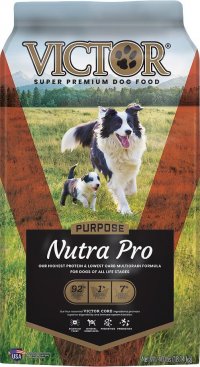
DogFoodAdvisor is reader supported See how
All reviews are 100% impartial but if you buy using links on this page, we may earn a referral fee.
Our Verdict
Victor Purpose Dry product range is made up of six recipes which each receive the Dog Food Advisor’s rating, 5 stars.
The table below shows each recipe in this range including our rating and the AAFCO nutrient profile: Growth (puppy), Maintenance (adult), All Life Stages, Supplemental or Unspecified.
| Product line | Rating | AAFCO |
|---|---|---|
| Victor Purpose Performance | 5 | M |
| Victor Purpose Nutra Pro | 5 | A |
| Victor Purpose Senior Healthy Weight | 5 | M |
| Victor Purpose Grain Free Active Dog And Puppy | 5 | A |
| Victor Purpose Grain Free Hero Canine | 5 | M |
| Victor Purpose Grain Free Ultra Pro | 5 | A |
Recipe and Label Analysis
Victor Purpose Nutra Pro was selected to represent the other products in the line for detailed recipe and nutrient analysis.
Victor Purpose Nutra Pro
Estimated Dry Matter Nutrient Content
Protein
Fat
CarbsCarbohydrates
Chicken meal, blood meal conventionally dried, whole grain millet, chicken fat (preserved with mixed tocopherols), yeast culture, grain sorghum, menhaden fish meal (source of DHA-docosahexaenoic acid), beef meal, dehydrated alfalfa meal, natural flavor, potassium chloride, carrot powder, tomato pomace, salt, organic dried seaweed meal, taurine, choline chloride, calcium stearate, zinc methionine complex, vitamin E supplement, dl-methionine, iron amino acid complex, hydrolyzed yeast, manganese amino acid complex, silicon dioxide, l-carnitine, selenium yeast, brewers dried yeast, copper sulfate, niacin supplement, vitamin B12 supplement, vitamin A supplement, d-calcium pantothenate, mono and diglycerides of fatty acids, thiamine mononitrate, biotin, yucca schidigera extract, calcium carbonate, riboflavin supplement, calcium iodate, pyridoxine hydrochloride, vitamin D3 supplement, tetrasodium pyrophosphate, rosemary extract, green tea extract, spearmint extract, inulin, lecithin, folic acid, dried bacillus coagulans fermentation product, dried bacillus subtilis fermentation product
Fiber (estimated dry matter content) = 3.5%
Red denotes any controversial items
| Estimated Nutrient Content | |||
|---|---|---|---|
| Method | Protein | Fat | Carbs |
| Guaranteed Analysis | 38% | 18% | NA |
| Dry Matter Basis | 42% | 20% | 30% |
| Calorie Weighted Basis | 35% | 40% | 25% |
Ingredients Analysis
The first ingredient in this dog food is chicken meal. Chicken meal is considered a meat concentrate and contains nearly 300% more protein than fresh chicken.
The second ingredient is blood meal. Blood meal is a by-product of slaughter and used to make high-protein (very low ash) animal feeds.
Yet even though some consider it a controversial ingredient, blood meal can still be considered a quality source of animal protein.
The third ingredient is millet, a gluten-free grain harvested from certain seed grasses. Millet is hypoallergenic and naturally rich in B-vitamins and fiber as well as other essential minerals.
The next ingredient is chicken fat. This item is obtained from rendering chicken, a process similar to making soup in which the fat itself is skimmed from the surface of the liquid.
Chicken fat is high in linoleic acid, an omega-6 fatty acid essential for life. Although it doesn’t sound very appetizing, chicken fat is actually a quality ingredient.
The fifth ingredient is yeast culture. Although yeast culture is high in B-vitamins and protein, it can also be used as a probiotic to aid in digestion.
The sixth item is sorghum. Sorghum (milo) is a starchy cereal grain with a nutrient profile similar to corn.
Since it is gluten-free and boasts a smoother blood sugar behavior than other grains, sorghum may be considered an acceptable non-meat ingredient.
The seventh ingredient is menhaden fish meal, another protein-rich meat concentrate.
Menhaden are small ocean fish related to herring. They’re rich in protein and omega-3 fatty acids. What’s more, in their mid-depth habitat, menhaden are not exposed to mercury contamination as can be typical with deep water species.
Fish meal is typically obtained from the “clean, dried, ground tissue of undecomposed whole fish and fish cuttings” of commercial fish operations.1
The eighth ingredient is beef meal, yet another high protein meat concentrate.
The ninth ingredient is alfalfa meal. Although alfalfa meal is high in plant protein (about 18%) and fiber (25%), this hay-family item is more commonly associated with horse feeds.
From here, the list goes on to include a number of other items.
But to be realistic, ingredients located this far down the list (other than nutritional supplements) are not likely to affect the overall rating of this Victor product.
With seven notable exceptions…
First, we find tomato pomace. Tomato pomace is a controversial ingredient, a by-product remaining after processing tomatoes into juice, soup and ketchup.
Many praise tomato pomace for its high fiber and nutrient content, while others scorn it as an inexpensive pet food filler.
Just the same, there’s probably not enough tomato pomace here to make much of a difference.
Next, dried seaweed meal is a product made from a family of brown algae known as Fucaceae (Rockweed). Although it does contain a number of healthy nutrients, seaweed meal is primarily used as a source of inexpensive carbohydrates (about 60% dry matter).
This item is only rarely used to make pet food and is more typically found in feeds for cattle, horses, hogs, hens and sheep.
In addition, brewers yeast can be a controversial item. Although it’s a by-product of the beer making process, this ingredient is rich in minerals and other healthy nutrients.
Fans believe yeast repels fleas and supports the immune system.
Critics argue yeast ingredients can be linked to allergies. This may be true, but (like all allergies) only if your particular dog is allergic to the yeast itself.
In addition, a vocal minority insists yeast can increase the risk of developing the life-threatening condition known as bloat. However, this is a claim we’ve not been able to scientifically verify.
In any case, unless your dog is specifically allergic to it, yeast can still be considered a nutritious additive.
What’s more noteworthy here is that brewers yeast contains about 48% protein, a factor that must be considered when judging the actual meat content of this dog food.
We also note the use of taurine, an important amino acid associated with the healthy function of heart muscle. Although taurine is not typically considered essential in canines, some dogs have been shown to be deficient in this critical nutrient.
Since taurine deficiency appears to be more common in pets consuming grain-free diets, we view its presence in this recipe as a positive addition.
Additionally, we note the inclusion of vegetable oil, a generic oil of unknown origin. The ratio of omega-6 to omega-3 fats in any oil is nutritionally critical and can vary significantly (depending on the source).
Without knowing more, it’s impossible to judge the quality of an item so vaguely described. However, compared to a named animal fat, a generic vegetable oil cannot be considered a quality ingredient.
Next, we find chelated minerals, minerals that have been chemically attached to protein. This makes them easier to absorb. Chelated minerals are usually found in better dog foods.
And lastly, this recipe contains selenium yeast. Unlike the more common inorganic form of selenium (sodium selenite), this natural yeast supplement is considered a safer anti-cancer alternative.
Nutrient Analysis
Based on its ingredients alone, Victor Purpose Dog Food looks like an above-average dry product.
The dashboard displays a dry matter protein reading of 42%, a fat level of 20% and estimated carbohydrates of about 31%.
As a group, the brand features an average protein content of 36% and a mean fat level of 19%. Together, these figures suggest a carbohydrate content of 37% for the overall product line.
And a fat-to-protein ratio of about 51%.
Which means this Victor product line contains…
Above-average protein. Above-average fat. And below-average carbs when compared to a typical dry dog food.
Even when you consider the protein-boosting effect of the yeast and alfalfa meal, this looks like the profile of a kibble containing a significant amount of meat.
Victor Dog Food Recall History
The following automated list (if present) includes all dog food recalls related to Victor through March 2025.
- Mid America Pet Food Expands Voluntary Recall to Include Additional Dog Food Products (November 10, 2023)
- Mid America Pet Food Issues Voluntary Recall of Victor Super Premium Dog Food – October 2023 (November 1, 2023)
- Mid America Pet Food Recall Victor Super Premium Dog Food, Hi-Pro Plus (October 3, 2023)
You can view a complete list of all dog food recalls since 2009 here.
Our Rating of Victor Purpose Dog Food
Victor Purpose includes both grain-inclusive and grain-free dry dog foods that use a significant amount of named meat meals as their dominant source of animal protein, thus earning the brand 5 stars.
Compare Victor Purpose Dog Food
How does Victor Purpose compare with The Dog Food Advisor's most recommended brands?
A Final Word
The Dog Food Advisor does not accept money, gifts, samples or other incentives in exchange for special consideration in preparing our reviews.
However, we do receive a referral fee from online retailers (like Chewy or Amazon) and from sellers of perishable pet food when readers click over to their websites from ours. This helps cover the cost of operation of our free blog. Thanks for your support.
For more information, please visit our Disclaimer and Disclosure page.







